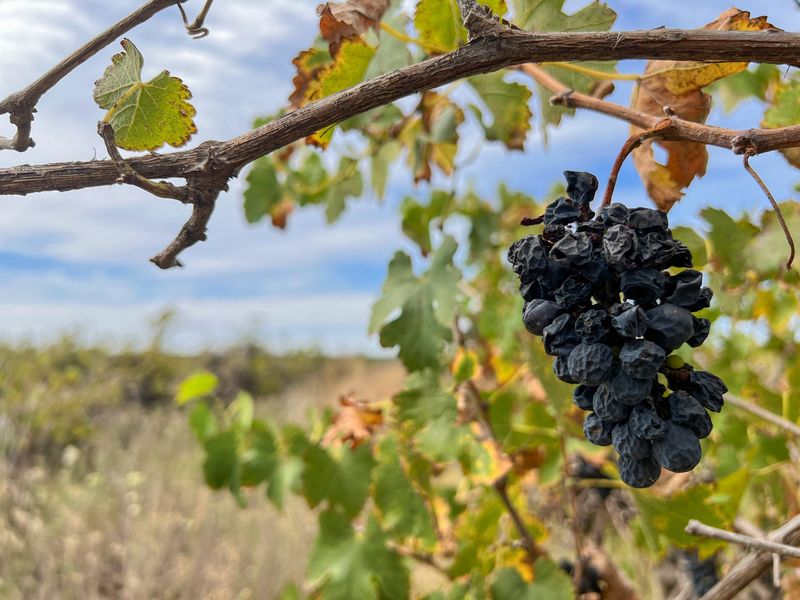
©Reuters. Unharvested grapes dry on the vine near the town of Griffith in southeast Australia February 26, 2024. REUTERS/Peter Hobson/File Photo
2/5
By Peter Hobson
GRIFFITH, Australia (Reuters) -Millions of vines are being destroyed in Australia and tens of millions more must be uprooted to curb overproduction that has crushed grape prices and threatens the livelihoods of growers and winemakers.
The decline in wine consumption worldwide has hit Australia particularly hard as demand contracts fastest for the cheaper reds that are its biggest product, and in China, the market it has relied on for growth until recent years.
The world’s fifth largest wine exporter had more than two billion liters, or about two years’ worth of production, in storage as of mid-2023, the latest data show, and some is spoiling as owners rush to dispose of it at any price.
“There’s only so much time we can keep growing a crop and lose money,” said James Cremasco, a fourth-generation farmer, as he watched the clang of yellow excavators tear up the rows of vines his grandfather had planted near the southeastern town of Griffith.
About two-thirds of Australia’s wine grapes are grown in irrigated inland areas such as Griffith, whose landscape is shaped by vine-growing techniques brought by Italian migrants who arrived around the 1950s.
As major wine producers such as Treasury Wines and Carlyle Group (NASDAQ:)’s Accolade Wines refocuses on more expensive bottles that sell better, areas around Griffith are struggling, with unpicked grapes wilting on the vines.
“It feels like an era is ending,” said Andrew Calabria, vineyard owner and third-generation winemaker at Calabria Wines.
“It’s hard for growers to look out the back window and see a pile of dirt instead of the vines that have been there as long as they’ve known.”
Nearby, the remains of 1.1 million vines that once made up one of Australia’s largest vineyards were piled in piles of gnarled and twisted wood as far as the eye could see.
Red wine is the one that has suffered the most. In regions like Griffith, prices for grapes for production fell to an average of A$304 ($200) a tonne last year, the lowest in decades and down from A$659 in 2020, shows data from industry body Wine Australia.
The government, which expects lower prices again this year, has said it recognizes the significant challenges facing growers and is committed to supporting the sector, although many growers say it can do more.
Cremasco said some of its red grapes were selling for just over A$100 a tonne.
To balance the market and raise prices, up to a quarter of vines in areas like Griffith need to be pulled up, said Jeremy Cass, head of Riverina Winegrape Growers, a farmers’ group in the area.
According to Reuters calculations based on data from Wine Australia, this would destroy more than 20 million vines across 12,000 hectares (30,000 acres), or about 8% of the total area planted with vines in Australia.
Growers and winemakers in other regions have also uprooted the vines.
“If half the vines in Australia were eradicated, it might not solve the oversupply,” a Western Australian wine producer said.
However, many growers unwilling to uproot the vines are losing money hoping for a market turnaround.
“It’s eating away at wealth,” said KPMG wine analyst Tim Mableson, who estimates that 20,000 hectares (49,000 acres) of vineyards will have to be eliminated nationwide.
GIVE IT AWAY
Health concerns are driving consumers around the world to drink less alcohol and, when they do drink wine, they are choosing more expensive bottles.
Chile, France and the United States are among other major wine producers grappling with oversupply, with prime areas such as Bordeaux having uprooted thousands of hectares of vineyards.
When China blocked imports during a political dispute in 2020, Australia lost its largest wine export market by value. And unlike Europe, it offers farmers no financial aid to help them destroy excess vines and wine.
While China is expected to allow imports again this month, that will not eliminate the glut, as demand has fallen much faster than elsewhere.
Wine selling for less than A$10 a liter – most made from grapes grown in areas such as Griffith – accounted for two-thirds of the value of Australian wine exports worth A$1.9 billion in the year to date in December 2023, Wine Australia says.
Some areas fare better, such as Tasmania and Victoria’s Yarra Valley, which produce more white wines and lighter, more expensive reds that are becoming increasingly popular.
But throughout Griffith there are clusters of metal storage tanks, each holding thousands of litres.
“Everyone is trying to lighten the wine,” said Bill Calabria, Andrew’s father, adding that wineries are “almost giving it away” to make room for the new vintage.
Many growers are turning to citrus and walnut trees instead.
Cremasco is hoping for more profits from the blackthorns it is planting on its uprooted acreage, while GoFARM, a company, is planting more than 600 hectares (1,500 acres) of almond trees nearby, also replacing vines.
“There will not be a next generation of family winemakers,” Cremasco added. “They will all be big companies and all the local young people will work for them.”
($1=1.5225 Australian dollars)